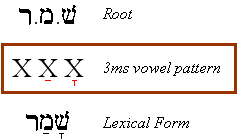|
The Qal Perfect Conjugation - Strong Verbs
The Qal Stem
The simplest form of the verbal root is known as Qal (ū¦ųĘū£), meaning "light" or "simple." Qal verbs represent the most basic of the verbal stems and are the easiest to learn. In most Hebrew dictionaries, verbs are listed in the 3rd person masculine singular of the Qal (when it exists).
Properties of the Qal stem include:
- Active Voice - the subject is agent of verb (e.g., "I guarded")
- Simple Aspect - the action of the verb is simple (i.e., not reflexive or causal)
The "Perfect" Conjugation: Suffixes
A conjugation is a set of inflected forms (of a given verb stem) based on person, gender, and number. The perfect conjugation is used to denote completed (i.e., "perfected") action. For now, think of the perfect conjugation as the past tense in the active voice.
The perfect conjugation for Qal verbs, then, is a set of inflected forms (of the Qal stem) that represents completed action performed by the subject of the verb.
The infections of the Qal stem are made by adding suffixes to the verb. These suffixes generally follow the sounds of the personal pronouns you have already studied.
Strong Verbs
As mentioned in the Introduction to this unit, Hebrew verb roots are divided according to whether the verb is regular or irregular with respect to one (or more) of its letters. Regular verbs are called  (shleimim) and have no weak letters (i.e., gutturals) in the shoresh. They are therefore called Strong verbs. In this section we will study the Qal Perfect Conjugation for regular verbs. (shleimim) and have no weak letters (i.e., gutturals) in the shoresh. They are therefore called Strong verbs. In this section we will study the Qal Perfect Conjugation for regular verbs.
Qal Perfect Conjugation - Strong Verbs
The root  is strong since none of its letters is a guttural. In a Hebrew lexicon, ū®ūüū×ū© would be listed as shamar, that is, with the vowels for the 3rd person masculine singular (3ms) of the Qal Perfect added. This is known as the "lexical form" of the verb: is strong since none of its letters is a guttural. In a Hebrew lexicon, ū®ūüū×ū© would be listed as shamar, that is, with the vowels for the 3rd person masculine singular (3ms) of the Qal Perfect added. This is known as the "lexical form" of the verb:

Note: Even though the "root" is referred to as  (with dots separating the letters), I will simply refer to it as shamar, which is also its lexical form. (with dots separating the letters), I will simply refer to it as shamar, which is also its lexical form.
The following conjugation shows the suffixes added to shamar to form the Qal perfect:
|







